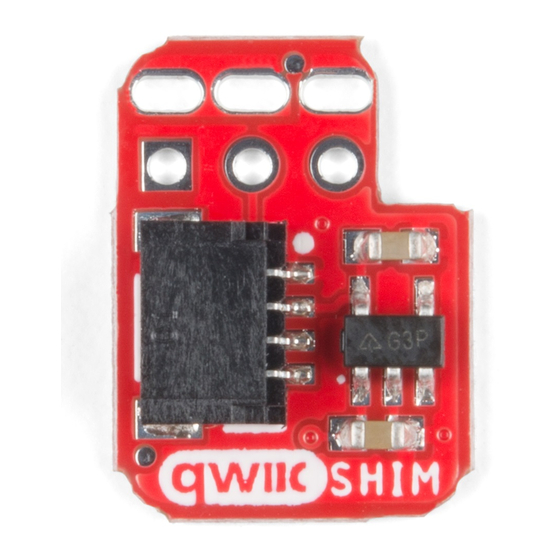
Advertisement
Quick Links
Qwiic SHIM for Raspberry Pi Hookup Guide
Introduction
The SparkFun Qwiic SHIM for Raspberry Pi is a small, easily removable breakout to add a Qwiic connector to your
Raspberry Pi. The SHIM (short for Shove Hardware in the Middle) design allows you to plug directly to the Pi's I C
bus with no soldering required and the thin PCB design allows for it to be sandwiched on your Pi GPIO with other
HATS. The Qwiic SHIM works great when you do not need the full capabilities of the Qwiic pHAT for Raspberry Pi
or if you want to add a Qwiic connector to your Pi but do not have room for yet another HAT.
SparkFun Qwiic SHIM for Raspberry Pi
DEV-15794
Product Showcase: SparkFun Qwiic SHIM for Raspberry Pi
Product Showcase: SparkFun Qwiic SHIM for Raspberry Pi
2
Advertisement

Summary of Contents for sparkfun Qwiic SHIM for Raspberry Pi
- Page 1 Introduction The SparkFun Qwiic SHIM for Raspberry Pi is a small, easily removable breakout to add a Qwiic connector to your Raspberry Pi. The SHIM (short for Shove Hardware in the Middle) design allows you to plug directly to the Pi's I C bus with no soldering required and the thin PCB design allows for it to be sandwiched on your Pi GPIO with other HATS.
- Page 2 Required Materials To follow along with this tutorial, you will need the following materials. You may not need everything though depending on what you have. Add it to your cart, read through the guide, and adjust the cart as necessary. Single Board Computer You will need Raspberry Pi with 2x20 male headers installed.
- Page 3 Now you probably wouldn't buy the Qwiic SHIM if you didn't have any Qwiic products to use with it, right? If you don't have any Qwiic products, the following might not be a bad place to start. SparkFun Micro OLED Breakout (Qwiic) SparkFun Atmospheric Sensor Breakout - BME280 (Qwiic) LCD-14532 SEN-15440 SparkFun Qwiic Keypad - 12 Button...
- Page 4 SparkFun Proximity Sensor Breakout - 20cm, COM-15290 VCNL4040 (Qwiic) SEN-15177 Finally, you'll need our handy Qwiic cables to easily connect sensors to your Qwiic SHIM. Below are a few options. Qwiic Cable - 100mm Qwiic Cable - 200mm ...
-
Page 5: Hardware Overview
Qwiic Connect System We would also recommend taking a look at the following tutorials if you aren't familiar with the content covered in them. Serial Terminal Basics An introduction to I2C, one of the main embedded This tutorial will show you how to communicate with communications protocols in use today. - Page 6 Top View Photo of Qwiic SHIM Press Fit Header The Press Fit Header on the Qwiic SHIM allows you to easily place the Qwiic SHIM on to your Pi (or other Single- Board Computer with the Pi GPIO) aligning the square pin on the Qwiic SHIM with Pin 1 of your GPIO. Pin one on the GPIO can be identified by the square pin or the beveled corner on the silkscreen.
- Page 7 For you savvy readers out there, you may wonder why not just connect directly to the 3.3V rail on the Pi GPIO? A simple answer is the Pi's 5V rail is able to source more current than the 3.3V rail so the regulator allows you to connect more devices to the I C bus without needing to worry about overtaxing your Pi.The on board AP2112K 3.3V regulator provides a clean 3.3V out for all attached Qwiic devices and can source up to 600mA@3.3V so you should have plenty of available current for your Qwiic project.
-
Page 8: Hardware Hookup
Hardware Hookup Getting started with the Qwiic SHIM is a snap (well, actually it's more like a push but you get the idea). Making sure to align the Qwiic SHIM's Pin 1 with Pin 1 on your Pi's GPIO header, press the Qwiic SHIM down onto the header. - Page 9 The Qwiic SHIM is seen here nicely wedged by the SparkFun Pulsed Radar Breakout And here you can see it shoved in the middle with the SparkFun Pi Servo HAT. Note: The Qwiic SHIM can also be connected in the same way with single board computers (like the NVIDIA Jetson Nano or the Google Coral) that utilize the 40-pin Raspberry Pi header footprint.
- Page 10 Python drivers for Qwiic breakouts available in the GitHub repository linked below. You can read more about Python for the SparkFun Qwiic system in this blog post. SPARKFUN QWIIC PY GITHUB REPO...
- Page 11 But I Already Have Sensors! If you already have a handful of SparkFun sensors and parts? SparkFun has been putting our standard GND/VCC/SDA/SCL pinout on all our I C boards for many years. This makes it possible to attach a Qwiic Adapter that will get your SparkFun I C sensor or actuator onto the Qwiic system.
- Page 12 Triple Axis Accelerometer - LIS3DH Triple Axis Magnetometer - MAG3110 Triple Axis Magnetometer - MLX90393 Compass Module - HMC6343 Atmospheric Sensor - BME280 Barometric Pressure Sensor - MS5803-14BA Barometric Pressure Sensor - T5403 Humidity and Temperature Sensor - Si7021 Digital Temperature Sensor - TMP102 Particle Sensor - MAX30105 Air Quality Sensor - CCS811 ToF Range Finder - VL6180...
















Need help?
Do you have a question about the Qwiic SHIM for Raspberry Pi and is the answer not in the manual?
Questions and answers